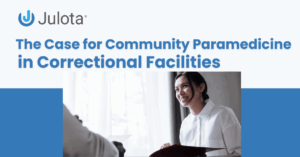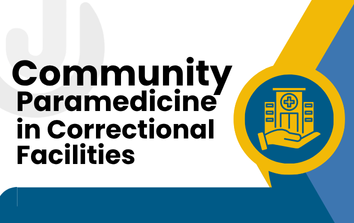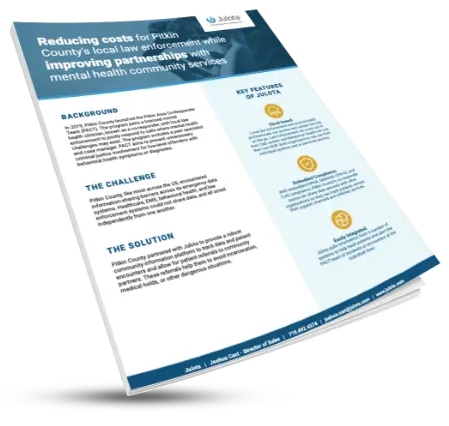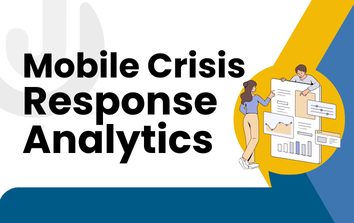Community paramedicine is a versatile healthcare tool that has the power to improve the conditions of people in correctional facilities, including those incarcerated in state prisons and those in local jails. Community paramedics help these people by reducing friction within the healthcare system, providing specialized treatments that may not be available (or go overlooked), and ensuring that strained health departments within correctional facilities have the resources they need.

How Community Paramedicine and Mobile Integrated Health Programs Can Impact People in Correctional Facilities
Community paramedicine is all about helping out people within society who may go overlooked. This means that they reach out to people struggling with severe substance abuse, people who may be homeless, people without reliable insurance, and even people in correctional facilities, including jails, prisons, and juvenile detention centers.
Some might ask: Why bother? Is it even worth the hassle? What good can it do to help people within correctional facilities when there are so many other people who need help? These are the questions that we work to answer in the following few segments of this article.
The benefits of Community paramedicine in correctional facilities:
- Having a Regular Connection to Healthcare Reduces the Friction of Transfer
- Helping Bring in Specialized Treatment and Equipment that May Not Be Available
- Assisting with the Transition Out of Correctional Facilities
- Providing Telehealth and Facilitating Care for More Complex Diseases
- Providing Assistance to Strained Health Systems within Correction Facilities
See more details below.
Having a Regular Connection to Healthcare Reduces the Friction of Transfer
The first way that community paramedicine can improve the situation in correctional facilities is by creating a stronger connection between what’s happening within the facility and what’s happening on the outside. Why is this important?
Often, when an inmate or otherwise incarcerated person needs a health assessment, there is confusion between the facility that’s sending them for care (the correctional facility) and the facility that is receiving them (usually, a hospital).
This causes many issues, including the hospital’s inability to prepare for the person they will need to intake (they may need to plan for added security or ensure that the person is placed in a specific area of the hospital), and a lack of clarity about their medical history.
Community paramedics can help ease this burden by creating a connection between the hospital and correctional facility.
Providing Specialized Treatment and Equipment for Correctional Facilities that May Not Be Available
Many correctional facilities must be mindful of their costs. This means they may not have access to all the latest medical equipment and procedures. And it might not just be that they don’t have the newest equipment, it could be that they don’t even have everything they need to maintain operations – or worse, that much of their equipment is failing or unreliable.
Whether this is true of a specific correctional facility will vary widely based on the area and the resources available. Regardless, community paramedicine can bring in helpful tools. Let’s talk about a few of them.
Among the things community paramedicine can provide is diagnostic care, including tools such as mobile blood labs, X-ray machines, or even CT scanners. If the correctional facility requires this type of medical equipment, this service can make a significant difference.
When a community paramedic brings in a medical tool, several advantages are present. First, (as we discussed), the correctional facility has access to something they might not have had access to before.
Second, instead of needing to send guards or correctional officers with the patient outside of the facility to receive care (which stresses resources), the MIH staff can be securely brought into the facility, making the process easier for everyone. Instead of dozens of security checks, there is just one or two for the team bringing in treatment.
Third, community paramedics can bring more than just diagnostic tools. They can provide treatments, including things like mental healthcare, wound care, and substance rehabilitation. Within the correctional facility, various types of spiritual and mental health care can have a tangible impact on what it means for a person when they leave the correctional facility and work to transition back to everyday life.
Assisting with the Transition Out of Correctional Facilities
One of the most significant struggle points for people leaving a correctional facility after a long period of detainment is a lack of support as they try to adjust outside. Sadly, many of these individuals turn back to repeat offenses, and before long, they end up back in the system.
The goal is to help these individuals make a truly new start. There are facilities designed to help people get back on their feet, but they often lack resources and require additional support for their clients. They need medical support, mental health care, and social services for people as they adjust to life outside of jail or prison. This is just one part of criminal justice reform that is taking place in many areas.
As it turns out, some of these services are precisely the things that community paramedicine specializes in. Community paramedics can form relationships with these individuals, helping guide them in areas of most need.
Some people might need careful help with avoiding or overcoming substance abuse, others might be very shaky in their housing situation or have no social support, and others might be really struggling with depression. In each of these cases, community paramedicine is there to connect them to a professional who is trained to help.
Of course, we can’t consistently achieve positive outcomes. Still, with programs like community paramedicine, we can at least make a strong effort to provide these individuals with the help they need, leading to small yet productive changes over weeks, months, and years.
Community Paramedicine for Correctional Facilities: Providing Telehealth and Facilitating Care for More Complex Diseases
There may be situations when someone in a correctional facility requires more serious medical care than just routine physical checkups. A few of these situations could include those people who have serious heart problems. Perhaps these people have had a heart attack in the past, or maybe they are at a high risk for a stroke. In these cases, the community paramedic can provide a detailed assessment facilitated by telehealth.
In another case, you might have a person who has severe seizures and needs in-depth assessments and careful management of their medications. Usually, it would be difficult for these individuals to be transported out of the facility to see a specialist, and in some cases, this wouldn’t be an option at all. However, with the power of community paramedicine, it’s possible to bring the specialist to the person in the correctional facility.
How does it work? Community paramedics are often trained in advanced hands-on assessments, including the use of ECGs, blood tests, and a wide range of neurological evaluations. The idea is that the community paramedic performs these tests in person while the specialist is on the phone. In this way, a cardiologist can obtain a comprehensive picture of their patient’s health without the need for an in-person visit. The community paramedic acts as the hands of the physician.
Aiding Strained Health Systems within Correction Facilities
In an already strained healthcare system, those who reside in correctional facilities can easily go overlooked. This is a bigger problem than many people realize. Why? Most people in correctional facilities will eventually be released and reintegrated into everyday life. Indeed, some are only detained for a few weeks to a few months. There are many more people in these facilities than people realize – especially in the United States.
If these people are overlooked, the broader public is impacted. Why? For one, there is the problem of spreading communicable diseases. If those in correctional facilities are not kept as healthy as possible, they could spread disease to the rest of the population.
Second, these individuals will eventually return to the world, and it’s in the best interest of the broader community for them to be healthy, both mentally and physically. Not only will this enhance the value of an area from a public health perspective, but it will also likely lead to reduced crime and safer streets.
Conclusion: The Methods Community Paramedicine Uses to Positively Impact Correctional Facilities
Community paramedicine has the potential to impact those in correctional facilities positively. They can do this with their broad range of tools and training. They can go directly into the correctional facility, reducing the need for people to be transported elsewhere. Not only that, but they can deliver specialized treatments and facilitate contact with the specialists (particularly when the person has a complex health condition).
Ultimately, community paramedicine facilitates the healthy transition of individuals out of correctional facilities, reintegrating them into their everyday lives with the overall goal of promoting better health for the entire community.
Contact Julota for more information on how their services can help your MIH team better plan and coordinate care for the people in your community.
Author
-

Noah Weinberg is a Marketing Associate at Julota, where he focuses on elevating the alternative response space, specifically Mobile Integrated Healthcare (MIH), Community Paramedicine, and co-responder models. He writes about the intersection of law enforcement, healthcare, and community well-being, drawing on real-world experiences with community paramedicine programs in Ontario, Canada.





